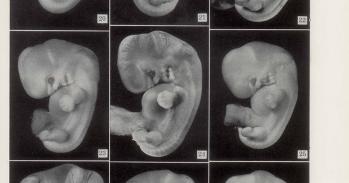
Research may explain how sperm travel long distances, through difficult terrain, to reach an egg.
Research may explain how sperm travel long distances, through difficult terrain, to reach an egg.
Our findings highlight the very subtle interplay between the geometry of the sperm cells and their response to fluid flow near the chamber walls
Raymond Goldstein
Like salmon travelling upstream to spawn, sperm cells are extremely efficient at swimming against the current. In a new study, researchers from the University of Cambridge and MIT have identified the physical mechanisms which may allow sperm to navigate inside the human body and stay on course through a variety of environments.
The research may help us to understand how some sperm travel such long distances, through difficult terrain, to reach and fertilise an egg. The results are published today in the journal eLife.
Of the hundreds of millions of sperm cells that begin the journey up the Fallopian tube, only a few hardy travellers will ever reach their destination. Not only do the cells have to swim in the right direction over distances that are around 1,000 times their own length, but they are exposed to different chemicals and currents along the way.
While we know that sperm cells can ‘smell’ chemicals given off by the egg once they get very close to it, this does not explain how they navigate for the majority of their journey, said Dr Jörn Dunkel of MIT, who conducted the research while a postdoctoral researcher at the University of Cambridge.
“We wanted to know which physical mechanisms could be responsible for navigation,” said Dunkel, who carried out the research in collaboration with Dr Vasily Kantsler, now at the University of Warwick, Martyn Blayney of Bourn Hall Clinic and Professor Raymond Goldstein of Cambridge’s Department of Applied Mathematics and Theoretical Physics. “If you think of salmon for example, they can swim against the stream, and the question was whether something similar could really be confirmed for human sperm cells.”
“There have been qualitative reports for over 100 years that sperm cells can swim upstream, but it is only recently that the role of surfaces bounding the flow has been established,” said Goldstein.
However, observing sperm cells swimming within the human body itself is no easy task. To understand what the cells are capable of, the researchers built a series of artificial micro-channels of different sizes and shapes, into which they inserted the sperm. They were then able to modify the flow of fluid through the tubes, to investigate how the cells responded to different current speeds.
They discovered that at certain flow speeds, the sperm cells were able to swim very efficiently upstream. “We found that if you create the right flow velocities, you can observe them swimming upstream for several minutes,” Dunkel said. “They’re very robust.”
Additionally, the researchers observed that the sperm were not swimming in a straight line upstream, but in a spiralling motion, along the walls of the channel. The sperm cells react to the difference in the speed of current near the walls of the chamber - where the fluid is attracted to the surface and is therefore at its slowest – and the free-flowing centre of the tube.
“Our findings highlight the very subtle interplay between the geometry of the sperm cells - the size of the head versus the side-to-side amplitude of the tail undulations - and their response to fluid flow near the chamber walls. A key component of this research was the development of a detailed mathematical model capable of explaining our diverse observations,” said Goldstein.
If biologists are able to observe similar fluid flow speeds within the Fallopian tube, it could help to confirm whether sperm cells are indeed using this mechanism to navigate through the body.
Not only would this improve our understanding of human reproduction, but it could also one day allow us to design new diagnostic tools and more efficient artificial insemination techniques. Reproduction specialists could take sperm samples and artificially recreate the conditions within the body to identify the cells that are the best swimmers, in a bid to pre-select those most likely to succeed.
Additionally, the researchers can experiment with different fluid viscosities within the micro-channels, to determine which results in the strongest upstream swimming effect. “So the idea would be to fine-tune the properties of the fluid medium that the sperm cells are contained in, before you insert it into the body, so that you know the cells can achieve optimal upstream swimming,” said Dunkel.
While much more work is still needed to determine if sperm cells behave in the same way in the much more complex terrain inside the Fallopian tube itself, the research gives us an important new insight into a mechanism that sperm may be using to navigate inside the human body.
In the meantime, the researchers plan to begin investigating whether sperm cells can work together to reach the egg. “There is a commonly held belief that there is competition between sperm cells, with the fittest reaching the egg first,” said Dunkel. “But we found in this paper that sperm always accumulate at the surface of the tube, and you can end up with a very high concentration of sperm cells, so there could actually be cooperation among these cells that allows them to swim faster collectively.”
The research was supported by the European Research Council.
Story adapted from MIT press release
The text in this work is licensed under a Creative Commons Licence. If you use this content on your site please link back to this page. For image rights, please see the credits associated with each individual image.





